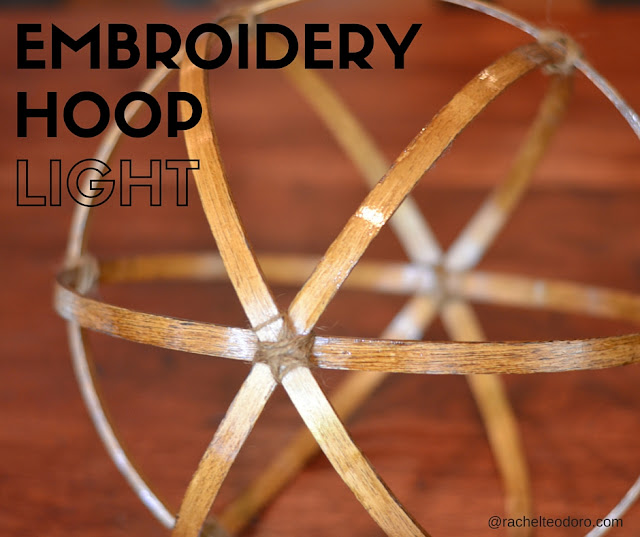A few months ago, a team of bloggers decided to get together for a thrift store challenge. The challenge was set to get paired up with a blogger who would send you a box of thrift store find(s) under $15 and you had the liberty to create whatever you wanted to create with those items. In case you missed it, you can
read more about the challenge here.
Today, I'm going to show you what I created with one of the items in my box. It's a project I've been wanting to make for quite some time. I'm so glad the challenge finally gave me the kick in the pants to make this embroidery hoop light. I love how it turned out and it's been a great addition to our back patio on our warm summer nights.
Let me take a second to refresh your memory. These are the items I received in my thrift store challenge box from Carol at
Refurbish 360 Blog. I had a few ideas in my mind, but I kept going back to my original idea of making an embroidery hoop light. In fact, I had already purchased the lighting package from IKEA last year with this project in mind. I just hadn't gotten around to doing it just yet.
I started by using some
Minwax stain in Bombay Mahogany. The same stain we used when we made our
removable plank top table last year. I put on two coats of the stain. I also had my IKEA lighting kit
{if you don't have an IKEA close by, this light kit is really reasonably priced as well} and
twine on hand. You will also need a lightbulb
{I love the look of the Edison bulbs.} This one is a fantastic deal.

After your hoops are dry, start by sliding all of the embroidery hoops inside one another. I used three on the inside and then one went down to support the middle. Start wrapping your twine around to hold your first meeting point together.
Slip the middle ring around and wrap that in place at the meeting points as well.
Once you have all your meeting points wrapped, take our your light kit and decide how far down you want your light to hand inside your hoop. You will take your twine and slip it around like shown at the spot you want it to meet with your hoop.
As you can see, the twine was placed about two inches up from the light base.
Secure the cord to the side of the embroidery hoop point that you consider the top.
My husband helped me find larger twine to wrap the cord and secure the lighting wire in place.
He is more of a boy scout than I am and knots are second nature to him. He ended up leaving a loop at the top so that there was a place to hang the light on our patio when it was complete.
After the light was complete, it found it's place outside on our back patio.
I think it looks pretty great above this seating area.
Having this lighting has made us linger just a little bit longer outside and enjoy the warm nights just a little bit longer.
In fact, we have even fired up the charcoal BBQ and created some
signature S'mores and enjoyed some amazing family time out back.
I was so happy to finally get this project that's been floating around in my head made. It's one of those things that I have enjoyed so much now, I wonder why I didn't make it sooner!
I also took the set of napkins that Carol sent and made some watercolor cloth napkins. I will have the full tutorial on that soon, but in the meantime, here's a sneak peak.
Take a second today to check out some of the other Thrift Store Challengers and see what they came up with!

dislaimer: this post may have affiliate links. By clicking on them and purchasing through them, I may receive a small commission. These small purchases help me to continue to keep writing content and creating at Holy Craft. Thank you!




























































